2007 CHEVROLET AVEO clutch
[x] Cancel search: clutchPage 109 of 436
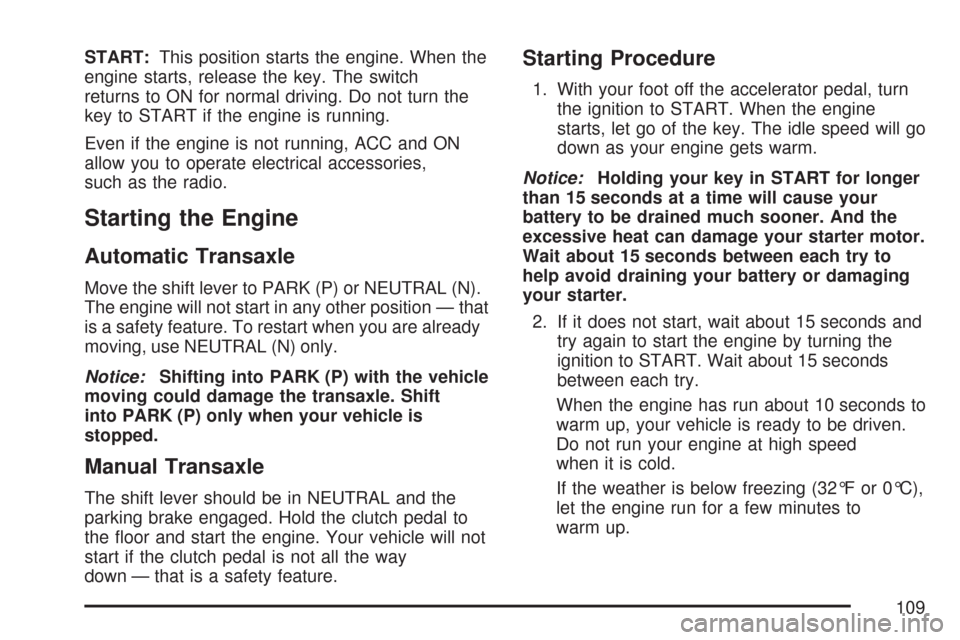
START:This position starts the engine. When the
engine starts, release the key. The switch
returns to ON for normal driving. Do not turn the
key to START if the engine is running.
Even if the engine is not running, ACC and ON
allow you to operate electrical accessories,
such as the radio.
Starting the Engine
Automatic Transaxle
Move the shift lever to PARK (P) or NEUTRAL (N).
The engine will not start in any other position — that
is a safety feature. To restart when you are already
moving, use NEUTRAL (N) only.
Notice:Shifting into PARK (P) with the vehicle
moving could damage the transaxle. Shift
into PARK (P) only when your vehicle is
stopped.
Manual Transaxle
The shift lever should be in NEUTRAL and the
parking brake engaged. Hold the clutch pedal to
the floor and start the engine. Your vehicle will not
start if the clutch pedal is not all the way
down — that is a safety feature.
Starting Procedure
1. With your foot off the accelerator pedal, turn
the ignition to START. When the engine
starts, let go of the key. The idle speed will go
down as your engine gets warm.
Notice:Holding your key in START for longer
than 15 seconds at a time will cause your
battery to be drained much sooner. And the
excessive heat can damage your starter motor.
Wait about 15 seconds between each try to
help avoid draining your battery or damaging
your starter.
2. If it does not start, wait about 15 seconds and
try again to start the engine by turning the
ignition to START. Wait about 15 seconds
between each try.
When the engine has run about 10 seconds to
warm up, your vehicle is ready to be driven.
Do not run your engine at high speed
when it is cold.
If the weather is below freezing (32°F or 0°C),
let the engine run for a few minutes to
warm up.
109
Page 116 of 436
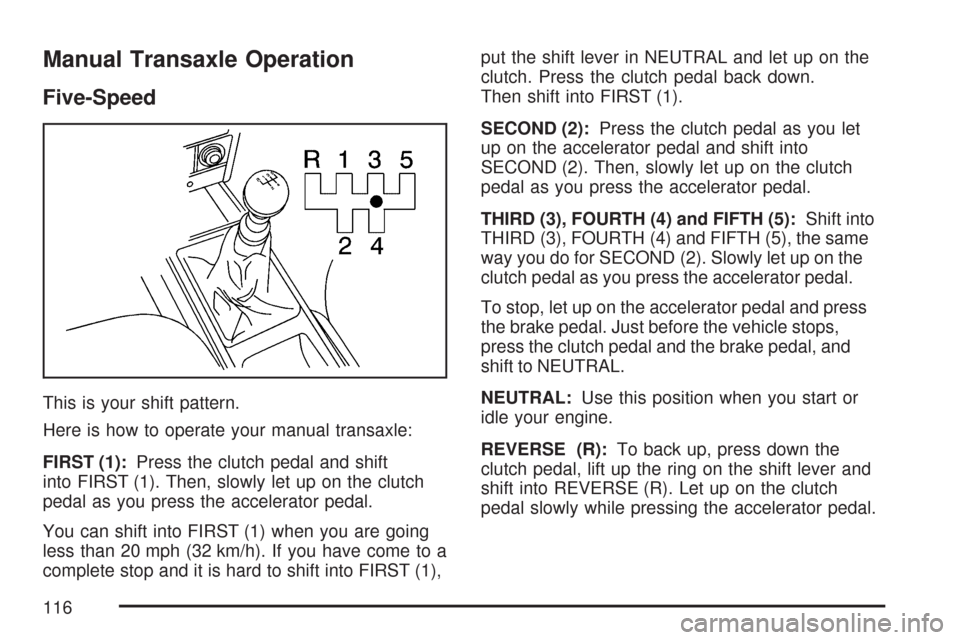
Manual Transaxle Operation
Five-Speed
This is your shift pattern.
Here is how to operate your manual transaxle:
FIRST (1):Press the clutch pedal and shift
into FIRST (1). Then, slowly let up on the clutch
pedal as you press the accelerator pedal.
You can shift into FIRST (1) when you are going
less than 20 mph (32 km/h). If you have come to a
complete stop and it is hard to shift into FIRST (1),put the shift lever in NEUTRAL and let up on the
clutch. Press the clutch pedal back down.
Then shift into FIRST (1).
SECOND (2):Press the clutch pedal as you let
up on the accelerator pedal and shift into
SECOND (2). Then, slowly let up on the clutch
pedal as you press the accelerator pedal.
THIRD (3), FOURTH (4) and FIFTH (5):Shift into
THIRD (3), FOURTH (4) and FIFTH (5), the same
way you do for SECOND (2). Slowly let up on the
clutch pedal as you press the accelerator pedal.
To stop, let up on the accelerator pedal and press
the brake pedal. Just before the vehicle stops,
press the clutch pedal and the brake pedal, and
shift to NEUTRAL.
NEUTRAL:Use this position when you start or
idle your engine.
REVERSE (R):To back up, press down the
clutch pedal, lift up the ring on the shift lever and
shift into REVERSE (R). Let up on the clutch
pedal slowly while pressing the accelerator pedal.
116
Page 121 of 436
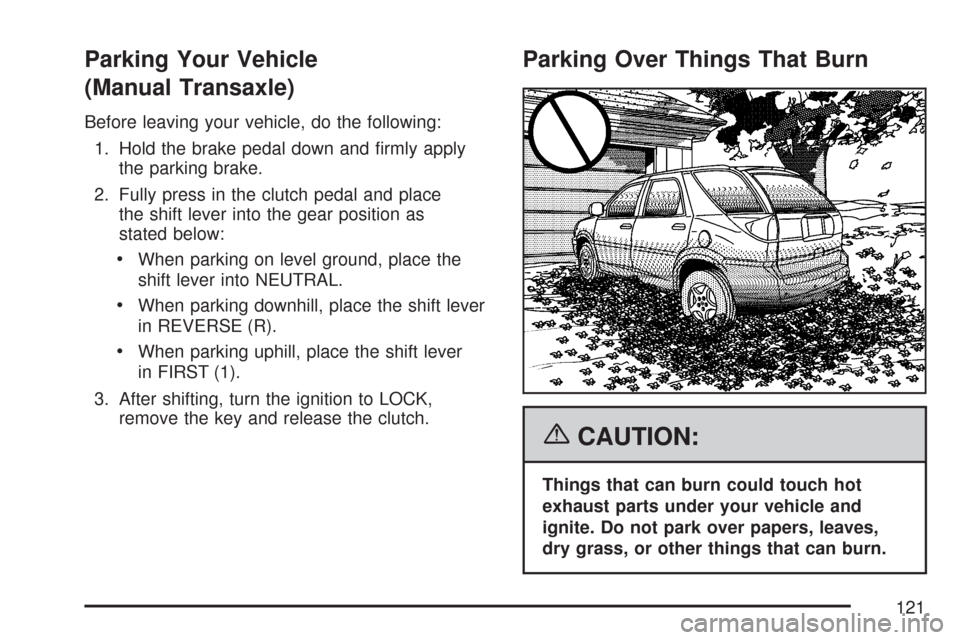
Parking Your Vehicle
(Manual Transaxle)
Before leaving your vehicle, do the following:
1. Hold the brake pedal down and firmly apply
the parking brake.
2. Fully press in the clutch pedal and place
the shift lever into the gear position as
stated below:
•When parking on level ground, place the
shift lever into NEUTRAL.
•When parking downhill, place the shift lever
in REVERSE (R).
•When parking uphill, place the shift lever
in FIRST (1).
3. After shifting, turn the ignition to LOCK,
remove the key and release the clutch.
Parking Over Things That Burn
{CAUTION:
Things that can burn could touch hot
exhaust parts under your vehicle and
ignite. Do not park over papers, leaves,
dry grass, or other things that can burn.
121
Page 141 of 436
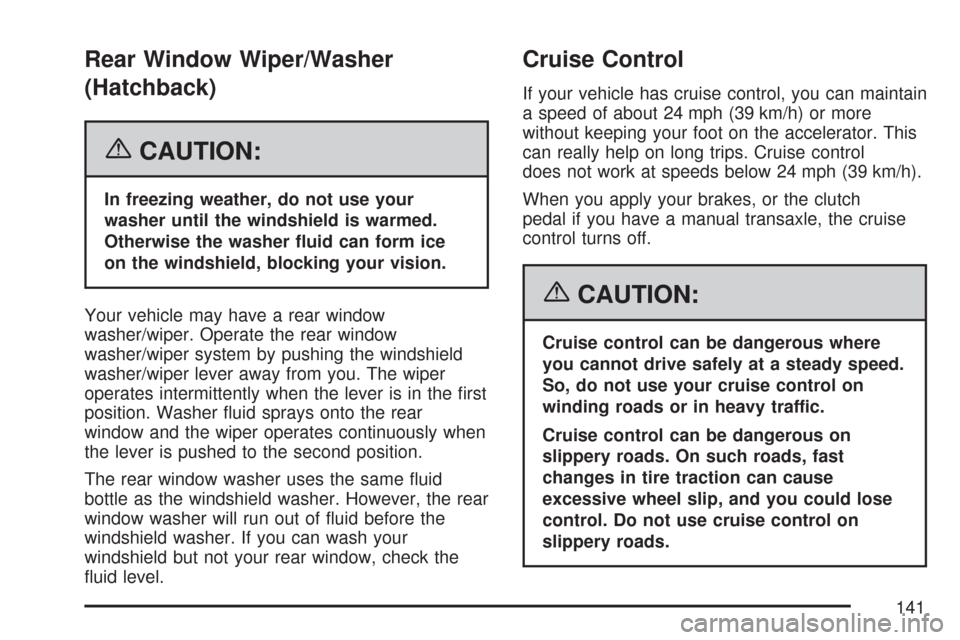
Rear Window Wiper/Washer
(Hatchback)
{CAUTION:
In freezing weather, do not use your
washer until the windshield is warmed.
Otherwise the washer �uid can form ice
on the windshield, blocking your vision.
Your vehicle may have a rear window
washer/wiper. Operate the rear window
washer/wiper system by pushing the windshield
washer/wiper lever away from you. The wiper
operates intermittently when the lever is in the first
position. Washer fluid sprays onto the rear
window and the wiper operates continuously when
the lever is pushed to the second position.
The rear window washer uses the same fluid
bottle as the windshield washer. However, the rear
window washer will run out of fluid before the
windshield washer. If you can wash your
windshield but not your rear window, check the
fluid level.
Cruise Control
If your vehicle has cruise control, you can maintain
a speed of about 24 mph (39 km/h) or more
without keeping your foot on the accelerator. This
can really help on long trips. Cruise control
does not work at speeds below 24 mph (39 km/h).
When you apply your brakes, or the clutch
pedal if you have a manual transaxle, the cruise
control turns off.
{CAUTION:
Cruise control can be dangerous where
you cannot drive safely at a steady speed.
So, do not use your cruise control on
winding roads or in heavy traffic.
Cruise control can be dangerous on
slippery roads. On such roads, fast
changes in tire traction can cause
excessive wheel slip, and you could lose
control. Do not use cruise control on
slippery roads.
141
Page 142 of 436
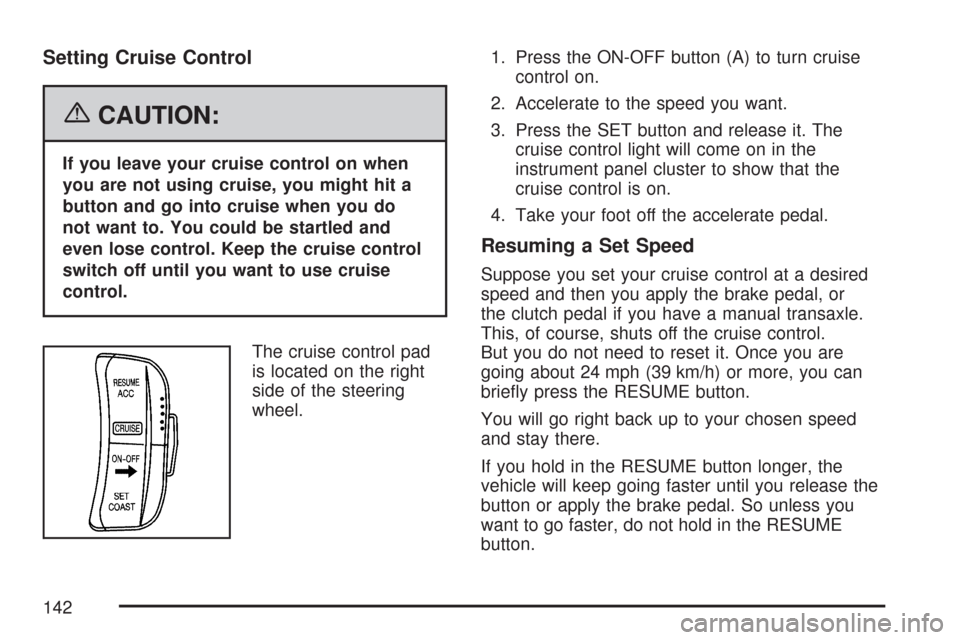
Setting Cruise Control
{CAUTION:
If you leave your cruise control on when
you are not using cruise, you might hit a
button and go into cruise when you do
not want to. You could be startled and
even lose control. Keep the cruise control
switch off until you want to use cruise
control.
The cruise control pad
is located on the right
side of the steering
wheel.1. Press the ON-OFF button (A) to turn cruise
control on.
2. Accelerate to the speed you want.
3. Press the SET button and release it. The
cruise control light will come on in the
instrument panel cluster to show that the
cruise control is on.
4. Take your foot off the accelerate pedal.
Resuming a Set Speed
Suppose you set your cruise control at a desired
speed and then you apply the brake pedal, or
the clutch pedal if you have a manual transaxle.
This, of course, shuts off the cruise control.
But you do not need to reset it. Once you are
going about 24 mph (39 km/h) or more, you can
briefly press the RESUME button.
You will go right back up to your chosen speed
and stay there.
If you hold in the RESUME button longer, the
vehicle will keep going faster until you release the
button or apply the brake pedal. So unless you
want to go faster, do not hold in the RESUME
button.
142
Page 144 of 436
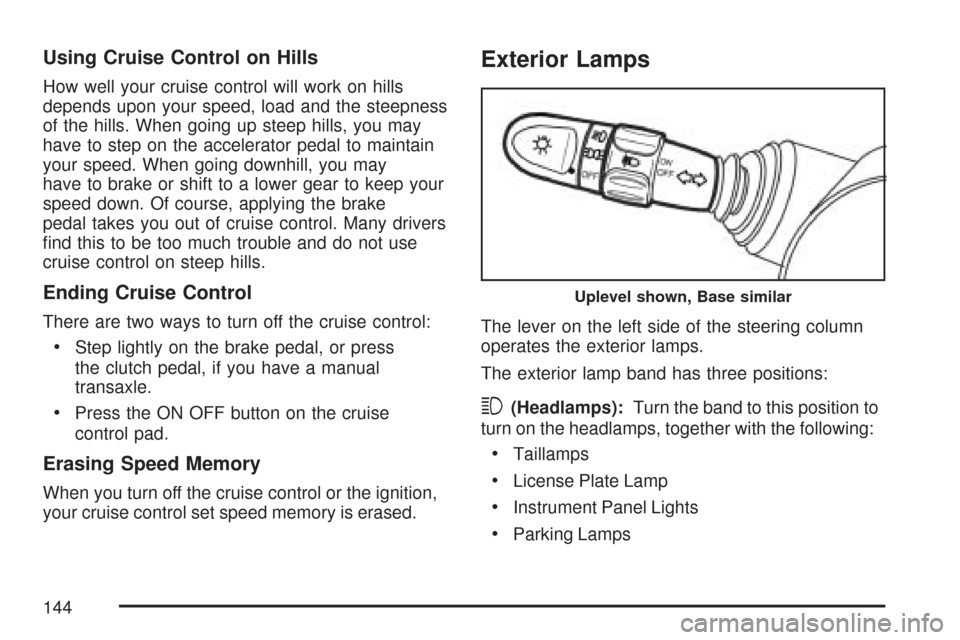
Using Cruise Control on Hills
How well your cruise control will work on hills
depends upon your speed, load and the steepness
of the hills. When going up steep hills, you may
have to step on the accelerator pedal to maintain
your speed. When going downhill, you may
have to brake or shift to a lower gear to keep your
speed down. Of course, applying the brake
pedal takes you out of cruise control. Many drivers
find this to be too much trouble and do not use
cruise control on steep hills.
Ending Cruise Control
There are two ways to turn off the cruise control:
•Step lightly on the brake pedal, or press
the clutch pedal, if you have a manual
transaxle.
•Press the ON OFF button on the cruise
control pad.
Erasing Speed Memory
When you turn off the cruise control or the ignition,
your cruise control set speed memory is erased.
Exterior Lamps
The lever on the left side of the steering column
operates the exterior lamps.
The exterior lamp band has three positions:
3(Headlamps):Turn the band to this position to
turn on the headlamps, together with the following:
•Taillamps
•License Plate Lamp
•Instrument Panel Lights
•Parking Lamps
Uplevel shown, Base similar
144
Page 261 of 436

Service........................................................ 264
Accessories and Modifications................... 264
California Proposition 65 Warning.............. 265
Doing Your Own Service Work.................. 265
Adding Equipment to the Outside of
Your Vehicle.......................................... 266
Fuel............................................................. 266
Gasoline Octane........................................ 266
Gasoline Specifications.............................. 266
California Fuel........................................... 267
Additives................................................... 267
Fuels in Foreign Countries........................ 268
Filling the Tank......................................... 269
Filling a Portable Fuel Container............... 272
Checking Things Under the Hood.............. 273
Hood Release........................................... 274
Engine Compartment Overview.................. 276
Engine Oil................................................. 277
Engine Air Cleaner/Filter............................ 281
Automatic Transaxle Fluid......................... 283Manual Transaxle Fluid............................. 285
Hydraulic Clutch........................................ 286
Engine Coolant.......................................... 287
Coolant Surge Tank Pressure Cap............ 290
Engine Overheating................................... 290
Cooling System......................................... 292
Power Steering Fluid................................. 297
Windshield Washer Fluid........................... 298
Brakes...................................................... 299
Battery...................................................... 303
Jump Starting............................................ 304
Headlamp Aiming........................................ 309
Bulb Replacement....................................... 309
Halogen Bulbs........................................... 309
Headlamps (Hatchback)............................. 310
Headlamps (Sedan)................................... 311
Front Turn Signal and Parking Lamps
(Hatchback)............................................ 312
Front Turn Signal and Parking Lamps
(Sedan).................................................. 313
Section 5 Service and Appearance Care
261
Page 277 of 436
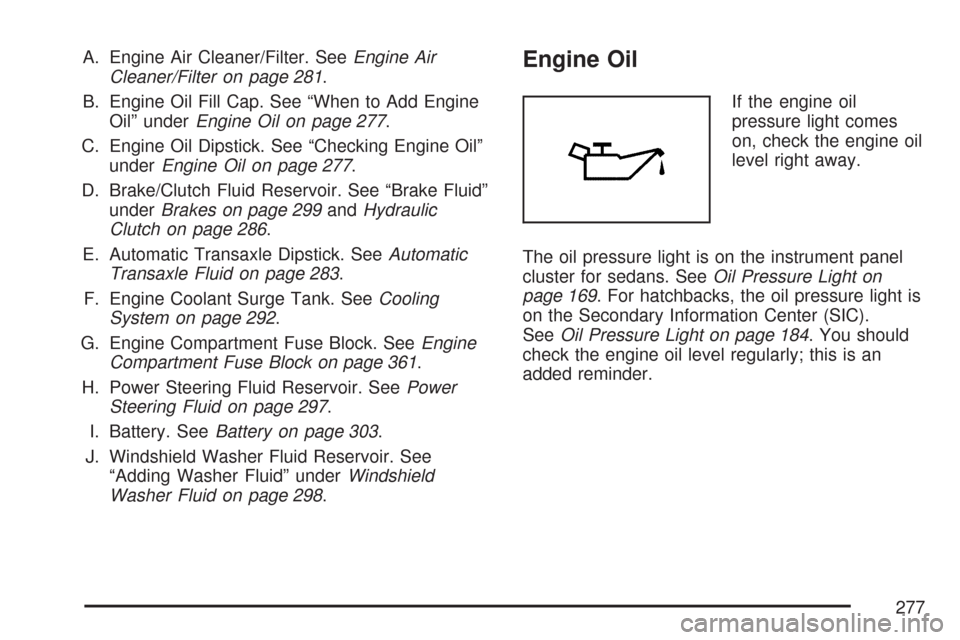
A. Engine Air Cleaner/Filter. SeeEngine Air
Cleaner/Filter on page 281.
B. Engine Oil Fill Cap. See “When to Add Engine
Oil” underEngine Oil on page 277.
C. Engine Oil Dipstick. See “Checking Engine Oil”
underEngine Oil on page 277.
D. Brake/Clutch Fluid Reservoir. See “Brake Fluid”
underBrakes on page 299andHydraulic
Clutch on page 286.
E. Automatic Transaxle Dipstick. SeeAutomatic
Transaxle Fluid on page 283.
F. Engine Coolant Surge Tank. SeeCooling
System on page 292.
G. Engine Compartment Fuse Block. SeeEngine
Compartment Fuse Block on page 361.
H. Power Steering Fluid Reservoir. SeePower
Steering Fluid on page 297.
I. Battery. SeeBattery on page 303.
J. Windshield Washer Fluid Reservoir. See
“Adding Washer Fluid” underWindshield
Washer Fluid on page 298.Engine Oil
If the engine oil
pressure light comes
on, check the engine oil
level right away.
The oil pressure light is on the instrument panel
cluster for sedans. SeeOil Pressure Light on
page 169. For hatchbacks, the oil pressure light is
on the Secondary Information Center (SIC).
SeeOil Pressure Light on page 184. You should
check the engine oil level regularly; this is an
added reminder.
277